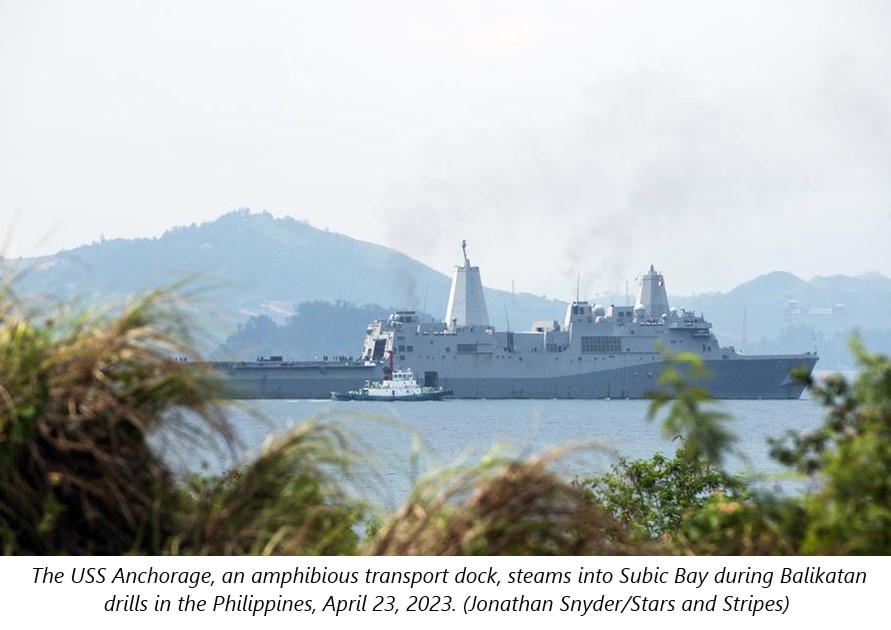Let’s Look at Asian Military Buildup!
By Eddie Burke and DONN LISTON
Notice to International Readers: This site can be read in six languages. Just peck the popup at the bottom of the page to change from English. Ang site na ito ay mababasa sa anim na wika. I-peck lang ang popup sa ibaba ng page para magpalit mula sa
Video clips included

Terms of an agreement 70 years ago–between China and India signed in 1954–has re-emerged as a cornerstone of China’s National Defense Policy in the New Era, as conflict with Philippines and other Asian neighbors continues with regard to ownership of parts of the west Philippines Sea, also called the South China Sea. Rational people know what to expect from any playground bully such as China President Xi Jinping, when weakness is detected as it is currently with USA President Joe Biden.
But underestimating resolve of the Filipino people at this time would likely be a grave mistake.
USA Military Buildup Unreported Anyplace Else

Alaskans in Philippines are witnessing the military buildup here and have collaborated on this report. Eddie Burke has gone to Subic Naval Station where he previously served in the US Navy during the early 1980s. He spent one week learning about what is happening and taking authentic videos.

In the old days, 7th Fleet ships were regular visitors, and the military population swelled when they pulled in. For young sailors and Marines, a trip outside the gate to Olongapo city was like traveling to Tijuana from San Diego, said Norman Tuzon who served there as a Marine and retired in the area more than a decade ago.
[1] Revived alliance brings US forces back to Subic Bay in the Philippines, Stars and Stripes, May 7, 2023

During the Vietnam conflict Alaska was the last American soil many recruits saw before flying to the conflict arena. Nearly 60,000 Americans died in that war.
China’s Current Rhetoric Regarding Peace Rings Hollow

[2] China’s Ministry of National Defense, Retrieved June 25, 2024
Over 4,000 years of recorded history, Chinese leaders have often referenced the past in hopes nobody else has their same long memory. Today that strategy is not working as the world observes China’s national defense policy statement lies.
[3] Thinking about China; 4,000 Years of Recorded History DONN LISTON, April 6, 2024
Remember they are still Communists…
From the Policy Statement:


Formerly known as the Panchsheel Agreement, the Five Principles were first agreed to between India’s first Prime Minister Jawaharlal Nehru and China’s first premier, Zhou Enlai assuring each other’s territorial integrity and peaceful coexistence. As part of that deal India gave up all territorial rights and privileges it enjoyed in Tibet, which it inherited from the British colonial legacy. India formally recognized Tibet to be a region of China.
Terms:
1. Mutual respect for each other’s territorial integrity and sovereignty
2. Mutual non-aggression
3. Mutual non-interference in each other’s internal affairs
4. Equal and mutual benefit working relationship
5. Peaceful co-existence

This Didn’t Last Long
[4] 63 years on, China wants to work with India on Panchsheel: 5 principles of the agreement, Hindustan Times, New Delhi, September 5, 2017
The Sino-Indian War, 1962
The Sino–Indian War, also known as the China–India War or the Indo–China War, was an armed conflict between China and India that took place from October to November 1962. It was a military escalation of the Sino–Indian border dispute. Fighting occurred along India’s border with China, in India’s North-East Frontier Agency east of Bhutan, and in Aksai Chin west of Nepal.
There had been a series of violent border skirmishes between the two countries after the 1959 Tibetan uprising, when India granted asylum to the Dalai Lama. Chinese military action grew increasingly aggressive after India rejected proposed Chinese diplomatic settlements throughout 1960–1962, with China resuming previously banned “forward patrols” in Ladakh after 30 April 1962. Amidst the Cuban Missile Crisis, China abandoned all attempts towards a peaceful resolution on 20 October 1962, invading disputed territory along the 3,225-kilometre (2,004 mi) border in Ladakh and across the McMahon Line in the northeastern frontier. Chinese troops pushed Indian forces back in both theatres, capturing all of their claimed territory in the western theatre and the Tawang Tract in the eastern theatre. The conflict ended when China unilaterally declared a ceasefire on 20 November 1962, and simultaneously announced its withdrawal to its pre-war position, the effective China–India border (also known as the Line of Actual Control).
[5] Sino-Indian War, Wikipedia, Retrieved June 25, 2024

Today China is Pushing Boundaries
MANILA — Video obtained by ABS-CBN News on Wednesday showed a small Chinese Coast Guard (CCG) vessel appearing to ram a Philippine boat during a resupply mission to Ayungin shoal last June 17.
The video from an ABS-CBN source showed at least two CCG vessels that appeared to be chasing the Philippine boat. One of the Chinese vessels sailed too close on the side of the Philippine boat, ending up in a slight collision.
[6] China Coast Guard rams PH boat during Ayungin mission, ABS-CBN News, June 19, 2024
In a related story at the same link:
It should now be clear to the international community that China’s actions are the true obstacles to peace and stability in the South China Sea, Defense Secretary Gilberto Teodoro Jr. said.
According to the DFA, the Philippines remains commitment to “pursue peace” and “rebuild a conducive environment for dialogue and consultation with China on the South China Sea.”
However, the DFA said “[t]his cannot be achieved if China’s words do not match their actions on the waters.”
On Tuesday, several allies expressed solidarity with Philippines, with the United States reiterating its mutual defense pact with Manila.
[7] DFA calls out China over injuries to troops, damage to boat
How Much Should Owner-State* Alaskans Care about the USA-China Relationship?

In 2011 Alaska exports to China totaled nearly $1.5 Billion, and China became our leading export destination surpassing Japan who had been our number one export destination since statehood in 1959. Annual exports to China were $1 Billion in 2017, according to Alaska Business Magazine. From the late 1970s to about 2015 China averaged 10% GDP growth annually but now is in decline.AK Joins Philippines-China Love/Hate Relationship 08/21/2023
Alaska doesn’t need a Belligerent China as our top trading partner. Philippines is our best friend in the world. We should be supporting our friends.

References:
[1] Revived alliance brings US forces back to Subic Bay in the Philippines, Stars and Stripes, May 7, 2023
https://www.stripes.com/theaters/asia_pacific/2023-05-07/subic-bay-philippines-navy-base-10046853.html
[2] China’s Ministry of National Defense, Accessed June 25, 2024
http://eng.mod.gov.cn/xb/DefensePolicy/index.html
[3] Thinking about China; 4,000 Years of Recorded History DONN LISTON, April 6, 2024
https://donnliston.co/2024/04/thinking-about-china-4000-years-of-recorded-history/
[4] 63 years on, China wants to work with India on Panchsheel: 5 principles of the agreement, Hindustan Times, New Delhi, September 5, 2017
https://www.hindustantimes.com/india-news/63-years-on-china-wants-to-work-with-india-on-panchsheel-5-principles-of-the-agreement/story-bpdO2LEIp3CBb4aGF3HaKM.html
[5] Sino-Indian War, Wikipedia, Retrieved June 25, 2024
https://en.wikipedia.org/wiki/Sino-Indian_War
[6] China Coast Guard rams PH boat during Ayungin mission, ABS-CBN News, June 19, 2024
https://news.abs-cbn.com/news/2024/6/19/dfa-calls-out-china-over-injuries-to-troops-damage-to-boat-1158
[7] DFA calls out China over injuries to troops, damage to boat
https://news.abs-cbn.com/news/2024/6/19/watch-china-coast-guard-rams-ph-boat-during-last-ayungin-mission-1331

Enjoyed your comment re China & the Philippines. Retired from the Navy after 32+ years and resided in the Philippines from 2016 to 2023. Returned to Bethel in 2023 where we own a home.
Thanks for your comment, Lee. We plan to expand coverage of what is happening here in a country that has closed borders and is run by rule of law. Let’s get together whenever you visit!